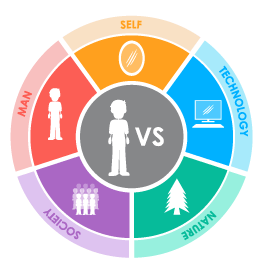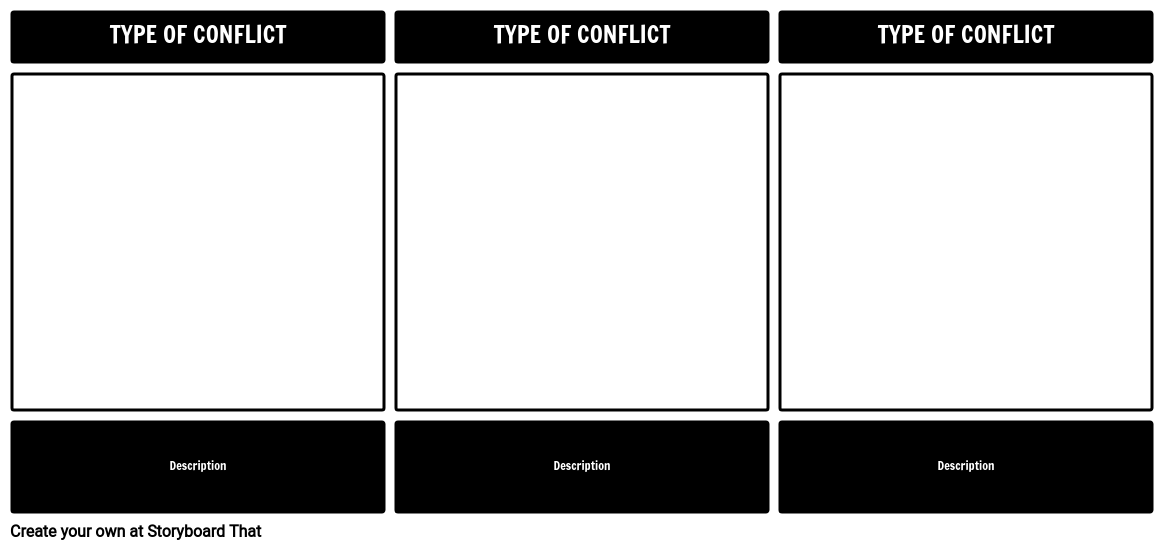Lesson Plan Overview
Literary conflicts are often taught during ELA units. Building on prior knowledge to achieve mastery level with our students is important. An excellent way to focus on the various types of literary conflict is through storyboarding. Having students choose an example of each literary conflict and depict it using the storyboard creator is a great way to reinforce your lesson!
In The Odyssey, conflict is constantly present. Much of the conflict arises from the obstacles Odysseus faces returning home. The wayward traveler and his crew battle against the dangers of the sea and the challenges of temptations. Odysseus constantly battles the supernatural world so he can return home.
Having students create storyboards that show the cause and effect of different conflicts will reinforce their ability to analyze literature.
Examples of Literary Conflict from The Odyssey
MAN vs. SELF
Odysseus struggles with himself. He convinces his men to tie him to the mast of the ship to hear the Siren's song.
MAN vs. NATURE
Odysseus struggles with nature. The whirlpool (Charybdis) swallows his boat, kills his men, and leaves him adrift in the sea.
MAN vs. SOCIETY
Odysseus struggles with society. After he returns home, he finds his house overrun with suitors.
Template and Class Instructions
(These instructions are completely customizable. After clicking "Copy Activity", update the instructions on the Edit Tab of the assignment.)
Student Instructions
Create a storyboard that shows at least three forms of literary conflict in The Odyssey.
- Identify conflicts in The Odyssey.
- Categorize each conflict as Character vs. Character, Character vs. Self, Character vs. Society, Character vs. Nature, or Character vs. Technology.
- Illustrate conflicts in the cells, using characters from the story.
- Write a short description of the conflict below the cell.
Check out our parts of a graphic novel article for more great ideas!
Lesson Plan Reference
Student Rubric
(You can also create your own on Quick Rubric.)
| Proficient | Emerging | Beginning | Try Again | |
|---|---|---|---|---|
| Conflict Identification | Student identifies correct major conflicts and uses strong, clear textual evidence to support choice. | Student identifies correct major conflict and uses few or unclear details to support their choice. | Student identifies incorrect major conflict, and uses some details from the text to support their choice. | Student does not attempt to identify major conflict or identifies incorrect major conflict with no explanation. |
| Understanding Outcome | Student clearly shows the outcome of the conflict and its effects on the protagonist with evidence from the text. | Student shows the outcome of the conflict and its effect on the protagonist, but some evidence is unclear. | Student shows the outcome of the conflict, but does not examine its effect on the protagonist and uses some vague textual evidence. | Student does not clearly show the outcome of the conflict or use textual evidence. |
| Character | Storyboard includes all required characters and clearly names them. Goes above and beyond by adding additional details. | Storyboard includes all required characters and clearly names them. | Storyboard includes protagonist and antagonist but leaves out other required characters. | Storyboard does not include the names of required characters. |
| Storyboard | Student clearly shows effort to convey the setting the scene of the book | Student attempts to convey setting and scene of the book, but lacks some clarity. | Student does not clearly convey the setting and scene. | Student makes little or no attempt to convey the setting or scene. |
| Spelling and Grammar | Student uses exemplary spelling and grammar. There are no errors. | Student makes a minor error in spelling and grammar. | Student makes several minor errors in spelling and grammar. | Student makes many errors in spelling and grammar; little attempt at spellchecking. |
Lesson Plan Overview
Literary conflicts are often taught during ELA units. Building on prior knowledge to achieve mastery level with our students is important. An excellent way to focus on the various types of literary conflict is through storyboarding. Having students choose an example of each literary conflict and depict it using the storyboard creator is a great way to reinforce your lesson!
In The Odyssey, conflict is constantly present. Much of the conflict arises from the obstacles Odysseus faces returning home. The wayward traveler and his crew battle against the dangers of the sea and the challenges of temptations. Odysseus constantly battles the supernatural world so he can return home.
Having students create storyboards that show the cause and effect of different conflicts will reinforce their ability to analyze literature.
Examples of Literary Conflict from The Odyssey
MAN vs. SELF
Odysseus struggles with himself. He convinces his men to tie him to the mast of the ship to hear the Siren's song.
MAN vs. NATURE
Odysseus struggles with nature. The whirlpool (Charybdis) swallows his boat, kills his men, and leaves him adrift in the sea.
MAN vs. SOCIETY
Odysseus struggles with society. After he returns home, he finds his house overrun with suitors.
Template and Class Instructions
(These instructions are completely customizable. After clicking "Copy Activity", update the instructions on the Edit Tab of the assignment.)
Student Instructions
Create a storyboard that shows at least three forms of literary conflict in The Odyssey.
- Identify conflicts in The Odyssey.
- Categorize each conflict as Character vs. Character, Character vs. Self, Character vs. Society, Character vs. Nature, or Character vs. Technology.
- Illustrate conflicts in the cells, using characters from the story.
- Write a short description of the conflict below the cell.
Check out our parts of a graphic novel article for more great ideas!
Lesson Plan Reference
Student Rubric
(You can also create your own on Quick Rubric.)
| Proficient | Emerging | Beginning | Try Again | |
|---|---|---|---|---|
| Conflict Identification | Student identifies correct major conflicts and uses strong, clear textual evidence to support choice. | Student identifies correct major conflict and uses few or unclear details to support their choice. | Student identifies incorrect major conflict, and uses some details from the text to support their choice. | Student does not attempt to identify major conflict or identifies incorrect major conflict with no explanation. |
| Understanding Outcome | Student clearly shows the outcome of the conflict and its effects on the protagonist with evidence from the text. | Student shows the outcome of the conflict and its effect on the protagonist, but some evidence is unclear. | Student shows the outcome of the conflict, but does not examine its effect on the protagonist and uses some vague textual evidence. | Student does not clearly show the outcome of the conflict or use textual evidence. |
| Character | Storyboard includes all required characters and clearly names them. Goes above and beyond by adding additional details. | Storyboard includes all required characters and clearly names them. | Storyboard includes protagonist and antagonist but leaves out other required characters. | Storyboard does not include the names of required characters. |
| Storyboard | Student clearly shows effort to convey the setting the scene of the book | Student attempts to convey setting and scene of the book, but lacks some clarity. | Student does not clearly convey the setting and scene. | Student makes little or no attempt to convey the setting or scene. |
| Spelling and Grammar | Student uses exemplary spelling and grammar. There are no errors. | Student makes a minor error in spelling and grammar. | Student makes several minor errors in spelling and grammar. | Student makes many errors in spelling and grammar; little attempt at spellchecking. |
How To Teach Literary Conflict to English Learners
Begin With Precise Definitions
Start by briefly defining the idea of literary conflict. Give examples of the various types of conflict that are frequently seen in literature, including internal conflict (character vs. self), external conflict (character vs. character, character vs. nature, character vs. society), and overarching struggle (character vs. fate).
Use Visual Aids
Graphic organizers and diagrams can assist English language learners grasp the various sorts of conflicts. To illustrate each sort of conflict and how it relates to the characters and the plot, use straightforward images.
Give Concrete Examples
Give learners relatable instances of disputes from your daily life to help them understand the idea. Talk about any issues your students may have at home, at school, or in their neighborhoods. Teachers can then draw a comparison between literary conflicts and real-life conflicts.
Make an Inclusive Environment
Teachers should encourage an inclusive environment where the students are comfortable sharing their confusion and questions. This inclusive environment can include giving examples from different cultures to make every student feel seen.
Conduct Activities
Teachers can use this subject to teach more vocabulary to students by conducting activities such as role-playing or identifying types of conflicts from different texts.
Frequently Asked Questions About Literary Conflict in The Odyssey
During his travels, what internal conflict does Odysseus face?
Odysseus struggles with inner tensions, especially between his desire to go home and his desire for adventure and renown. Along with dealing with doubt and dread, he frequently battles with his own feelings and choices.
What conflict between character and nature is best exemplified by the encounter with the Cyclops Polyphemus?
When Odysseus and his companions are faced against the monstrous Cyclops and the arid, hostile climate of his island, the fight with Polyphemus is one example of conflict between character and nature.
How is Penelope affected by the battle with the suitors?
As she navigates societal pressures and the unwanted attention of the suitors, Penelope encounters a character vs. society dilemma. The story's intensity is heightened by her devotion to Odysseus and her deft use of delay tactics.
What internal turmoil is shown by Odysseus' meeting with the Lotus-Eaters?
As some of his crewmen get seduced by the plant of the Lotus-Eaters and lose sight of their desire to return home, Odysseus experiences internal struggle. He must choose between compelling them to complete the trek and letting them continue to experience the lotus's effects.
More Storyboard That Activities
Odyssey, The
This Activity is Part of Many Teacher Guides
Testimonials

“By using the product, they were so excited and they learned so much...”–K-5 Librarian and Instructinal Technology Teacher

“I'm doing a Napoleon timeline and I'm having [students] determine whether or not Napoleon was a good guy or a bad guy or somewhere in between.”–History and Special Ed Teacher

“Students get to be creative with Storyboard That and there's so many visuals for them to pick from... It makes it really accessible for all students in the class.”–Third Grade Teacher
© 2026 - Clever Prototypes, LLC - All rights reserved.
StoryboardThat is a trademark of Clever Prototypes, LLC, and Registered in U.S. Patent and Trademark Office












